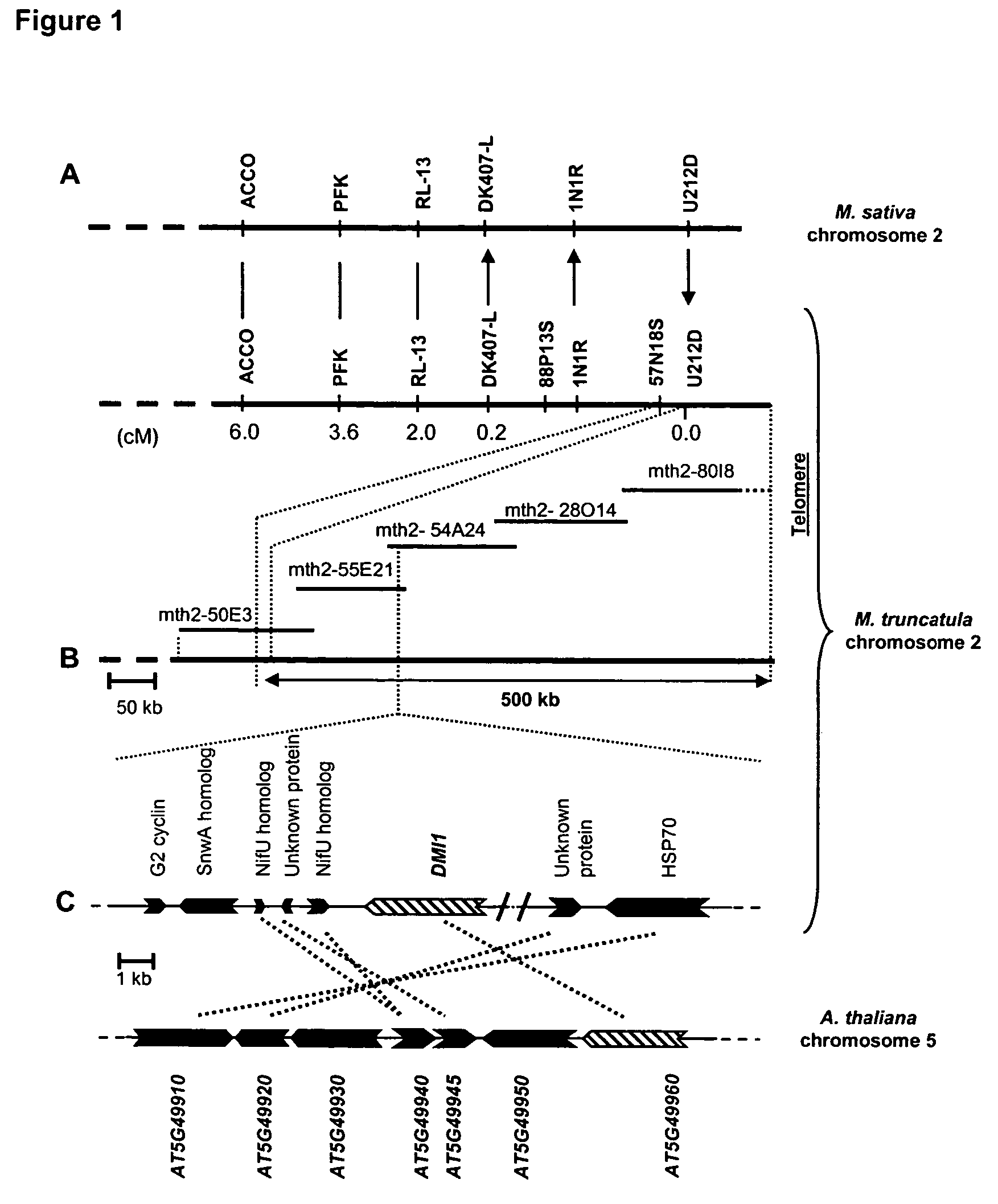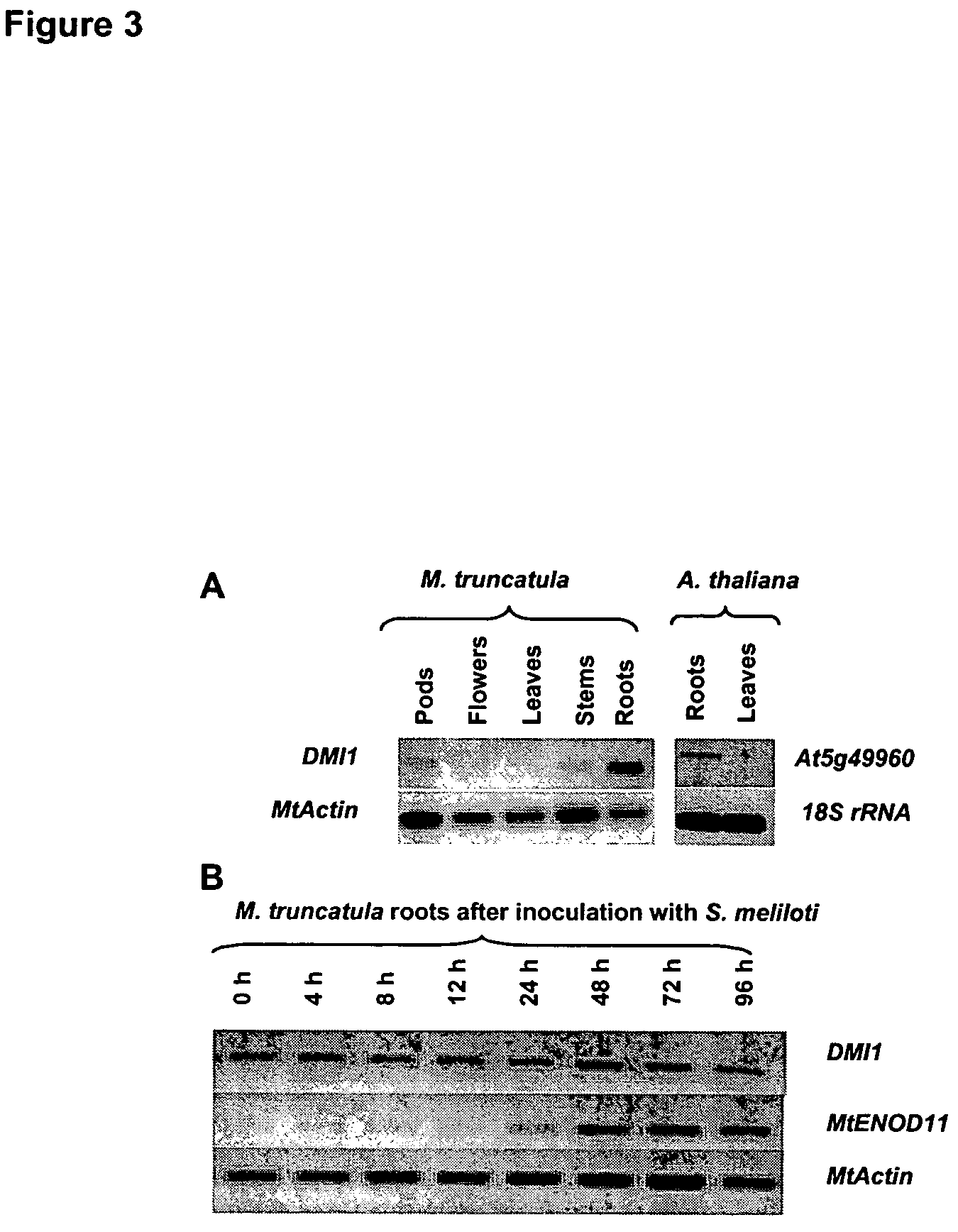DMI1 gene encodes a protein that is required for the early steps of bacterial and fungal symbioses
a bacterial and fungal symbiosis and protein technology, applied in the field of plant nitrogen fixation and phosphate uptake, can solve the problem of inability to form root nodules that are produced in wild type i>m. truncatula, and achieve the effect of enhancing symbiosis
- Summary
- Abstract
- Description
- Claims
- Application Information
AI Technical Summary
Benefits of technology
Problems solved by technology
Method used
Image
Examples
example 1
Cloning DMI1 from M. truncatula
[0119]By means of genetic and cytogenetic analyses DMI1 was previously localized to one extremity of M. truncatula chromosome 2 (Ané et al. 2002). Genetic marker 1N1R, which defined the telomere end of linkage group 2 and was invariantly linked to the DMI1 locus in an F2 population of 499 Nod− individuals, was used to seed a chromosome walk towards DMI1. In parallel to physical mapping, knowledge of chromosomal synteny between M. truncatula and M. sativa (Choi et al. 2003) was used to systematically position new genetic markers between 1N1R and the telomere. Genetic mapping of 1N1R in M. sativa revealed a single genetic marker, U212D, that was telomeric of 1N1R in both species (FIG. 1A). Using U212D as probe, additional BAC clones (e.g., mth2-50E3) of M. truncatula were identified and a 1.2 Mb contig extending from genetic marker 88P13S to the adjacent telomere of chromosome 2 was rapidly completed (FIG. 1).
[0120]Genotyping of >1,500 individuals ident...
example 2
Transgenic Complementation of DMI1 in Plant Root
[0122]To confirm that the identified gene was DMI1, we analyzed the ability of wild type DMI1 gene to complement the Nod− Myc− phenotype of the mutants. In a previous study, we have shown that the nodulation phenotype of the dmi mutants is determined by the genotype of the root (Ané et al., 2002). As such it was possible to use the Agrobacterium rhizogenes mediated transformation to complement the dmi1 mutation (Boisson-Dernier et al., 2001).
[0123]The full length wild type DMI1 cDNA was amplified in a pCR2.1 vector (Invitrogen). 1.6 kb of the promoter sequence was also amplified from mth2-54A24 and cloned upstream of the cDNA. The whole construct was introduced into the pCAMBIA-1303 binary vector (clone pCAMBIA-DMI1). A. rhizogenes strain Arqua1 containing the pCH32 vector carrying virE and virG virulence genes was used for transformation. pCAMBIA-DMI1 and pCAMBIA-1303 (as a negative control) were introduced into Arqua1 (pCH32) strain....
example 3
Expression Analysis of DMI1
[0124]The expression of DMI1 was analyzed by means of semi-quantitative RT-PCR (FIG. 3A). RNAs were extracted using RNeasy Plant Minikit (Qiagen, Germany) and quantified with Ribogreen RNA quantitation kit (Molecular Probes, USA). RT-PCR experiments were performed using the PowerScript™ RT-PCR kit (Clontech laboratories, USA). The results indicated that DMI1 is constitutively expressed in roots, with lower levels of transcript detected in pods, flowers, leaves and stems. Treatments known to activate expression of plant “nodulin genes”, including inoculation with the compatible symbiotic bacterium Sinorhizobium meliloti (FIG. 3B) or 10−9 M cognate Nod factors (data not shown), had no effect on DMI1 transcript levels.
PUM
| Property | Measurement | Unit |
|---|---|---|
| nucleic acid | aaaaa | aaaaa |
| nucleic acid sequence | aaaaa | aaaaa |
| nucleic acid sequences | aaaaa | aaaaa |
Abstract
Description
Claims
Application Information
 Login to View More
Login to View More - R&D
- Intellectual Property
- Life Sciences
- Materials
- Tech Scout
- Unparalleled Data Quality
- Higher Quality Content
- 60% Fewer Hallucinations
Browse by: Latest US Patents, China's latest patents, Technical Efficacy Thesaurus, Application Domain, Technology Topic, Popular Technical Reports.
© 2025 PatSnap. All rights reserved.Legal|Privacy policy|Modern Slavery Act Transparency Statement|Sitemap|About US| Contact US: help@patsnap.com



